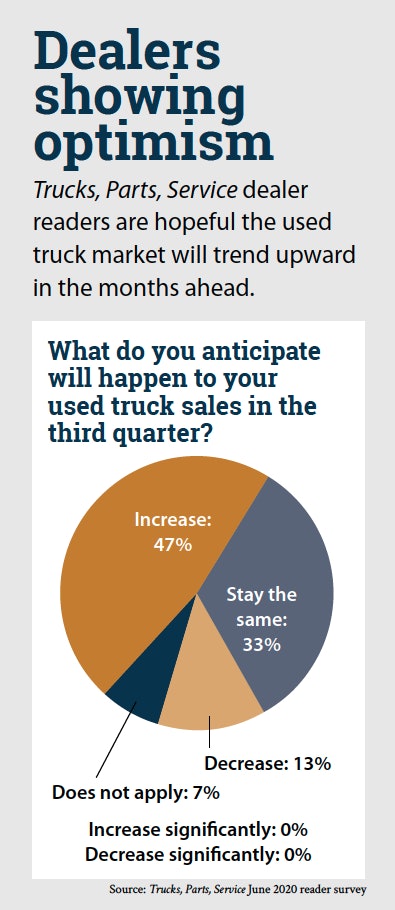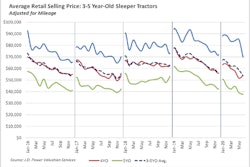The following is Part 1 of a 12-part special report from Trucks, Parts, Service on the state of the used truck market.
 .
.Anyone who spends more than a few years moving used equipment understands the ebb and flow of the used truck market. When business is good it can feel as if supply will never overtake demand. Volumes rise and fall like the tide but prices remain buoyant, seemingly impervious to the undertow of market conditions.
Yet when business does change, it changes quickly. Equipment prices that held up against stiff competition for months can sink like a stone. Though this volatility pales in comparison with the wild order fluctuations experienced in the new truck space, its abrupt nature means used truck dealers are always aware of the next storm on the horizon.
Well, almost always. The used truck market was prepared for a potential downturn in 2020; it was not prepared for COVID-19.
“We expected the first six months of 2020 to continue to be a challenge,” says KEA Advisors’ John Whitnell, who develops the company’s used market reports.
Whitnell says KEA Advisors’ research indicated domestic economic and trucking performance entering 2020 appeared strong enough to support used truck demand at historical and current pricing levels, but other used metrics such as high inventory concerns led the company to provide a measured prediction for the market entering the year.
The team was more bullish for the second half, noting at the time “lower supply and declining inventory levels should stabilize prices in the second half of the year. We might even see some lift in the second half of 2020.”
Learn how to move your used trucks faster
With unsold used inventory depreciating at a rate of more than 2% monthly, efficient inventory turnover is a must for dealers. Download this eBook, “Sold! Best Practices for Moving Used Trucks,” to access proven strategies for selling used trucks faster.
Looking back, Whitnell says the analysis was solid. The medium- and heavy-duty retail markets were performing “as expected” entering March, with auction sales helping stabilize inventory, year-over-year sales comparable and asking prices leveling out.
“[The first quarter] of 2020 was pretty good from the used truck market; our forecast was setting up as we thought it might,” he says.
That changed in March when the reality of the coronavirus pandemic abruptly upended life across North America. Businesses closed en masse; entire industries were permanently altered without warning. Trucking companies and most of their dealer partners were able to remain open as essential operations, but business plans across the industry were universally destroyed.
Three of every four used truck dealers responding to a Trucks, Parts, Service (TPS) reader survey on business conditions in June indicated their used truck sales revenues had decreased since COVID-19 overwhelmed North America. The fourth segment of dealers said their sales were even worse, having “decreased significantly.”
“We saw some checking in the market late last year before COVID hit, but we couldn’t have anticipated anything like this,” says Craig Kendall, specialty markets manager, The Pete Store and Used Truck Association (UTA) president. “We actually managed to have a pretty good March thanks to some panic buying as soon as [the pandemic] began, but business certainly checked up in April.”
The story was similar across the market.
In Delaware at Bayshore Ford, used truck sales pinged up and down in the early weeks of the pandemic before stabilizing with the freight market, says Amy Shahan, buyer/seller at the dealership and UTA vice president.
Focused primarily on the medium-duty space, Bayshore’s clientele of mostly essential businesses aren’t buying quite as much as they would in a normal year but Shahan says demand hasn’t totally evaporated.
“We’re not having anybody come around to kick tires. People are coming in because they need a truck,” she says.
In California, Riverside Trucks & Equipment President Ron Nelthorpe says his business was anticipating a substantial uptick in used truck sales after an uneven 2019 and was on its way to that goal when coronavirus arrived. He cites California’s early enacting of shelter-in-place orders and strict emission regulations for heavy trucks as barriers to moving used trucks during the pandemic, even though some customers still want to buy.
“People are realizing now they can make a living with a $50,000 truck but it’s dang tough to do so with a $100,000 truck,” Nelthorpe says.
That sentiment has helped calm the retail used market, which KEA Advisors estimates was down about 10 percent year over year in March and April, Whitnell says.
 Click to enlarge
Click to enlarge“As pandemics go, I think we’re getting through this one in very good shape,” he says. “Demand is off a bit but not catastrophically so. Retail asking and retail take prices are holding for the time being.”
J.D. Power’s market data seems to confirm that assessment, says Senior Analyst and Product Manager for Commercial Vehicles Chris Visser. Though retail pricing slipped a bit in May and June as more trucks were sold, Visser says J.D. Power’s assessment of the retail market through June indicated pricing had fallen 15 percent from 2019.
Yet the relative health of the retail space hasn’t been without consequences.
When freight volume started falling in late March and April many used truck dealers chose to adjust their inventory practices, keeping only high-demand units for the retail market and offloading everything else into the auction/wholesale space.
Visser says the strategy suppressed auction prices at more than double the rate of the retail market through April before a slight bounce back in May.
Whether that bounce back continues will be determined by the greater economy. Experts believe the latter half of the year will be defined by replacement demand. If COVID-19 can be managed and businesses can reopen, Visser says, “I see at least some balancing against the supply and the demand for used trucks.”
Additionally, Nelthorpe’s assessment that new truck sales are likely to remain dormant into the fall is shared by many in the industry. Even carriers willing to place orders today are unlikely to see their new equipment until 2021, meaning used trucks will be necessary to keep freight moving.
Whitnell says proactive used truck dealers should be able to leverage this opportunity into a strong close to the year. He says dealers who manage their inventory well, price their trucks right and leverage the marketing resources that exist in the channel have the potential to rebound from earlier struggles.
Regarding inventory management in particular, research by Randall-Reilly, publisher of TPS, indicates dealers who are able to turn their used truck inventory in 64 days — more than a month better than industry averages — see a more than 33 percent higher return on their equipment than competitors.
Says Whitnell, “This is the wrong time to be talking yourself into a recession. Retail demand is still solid. People are buying trucks. Make sure you are on the deals.”










